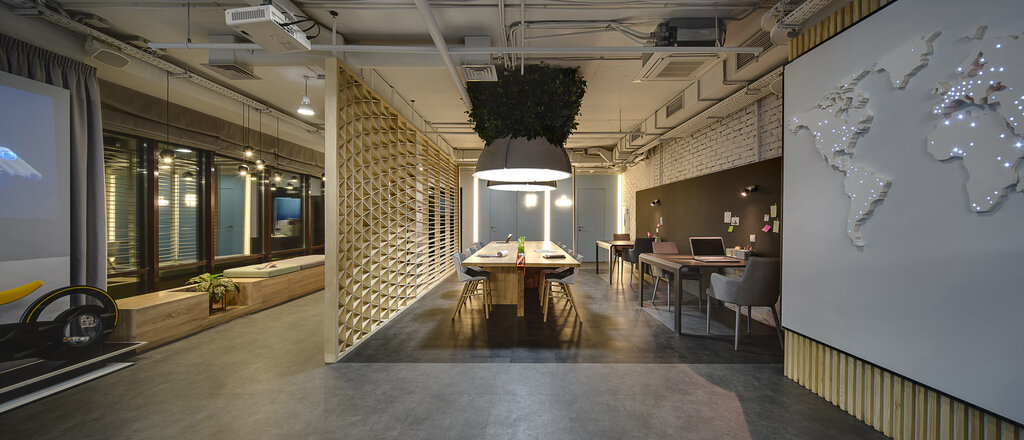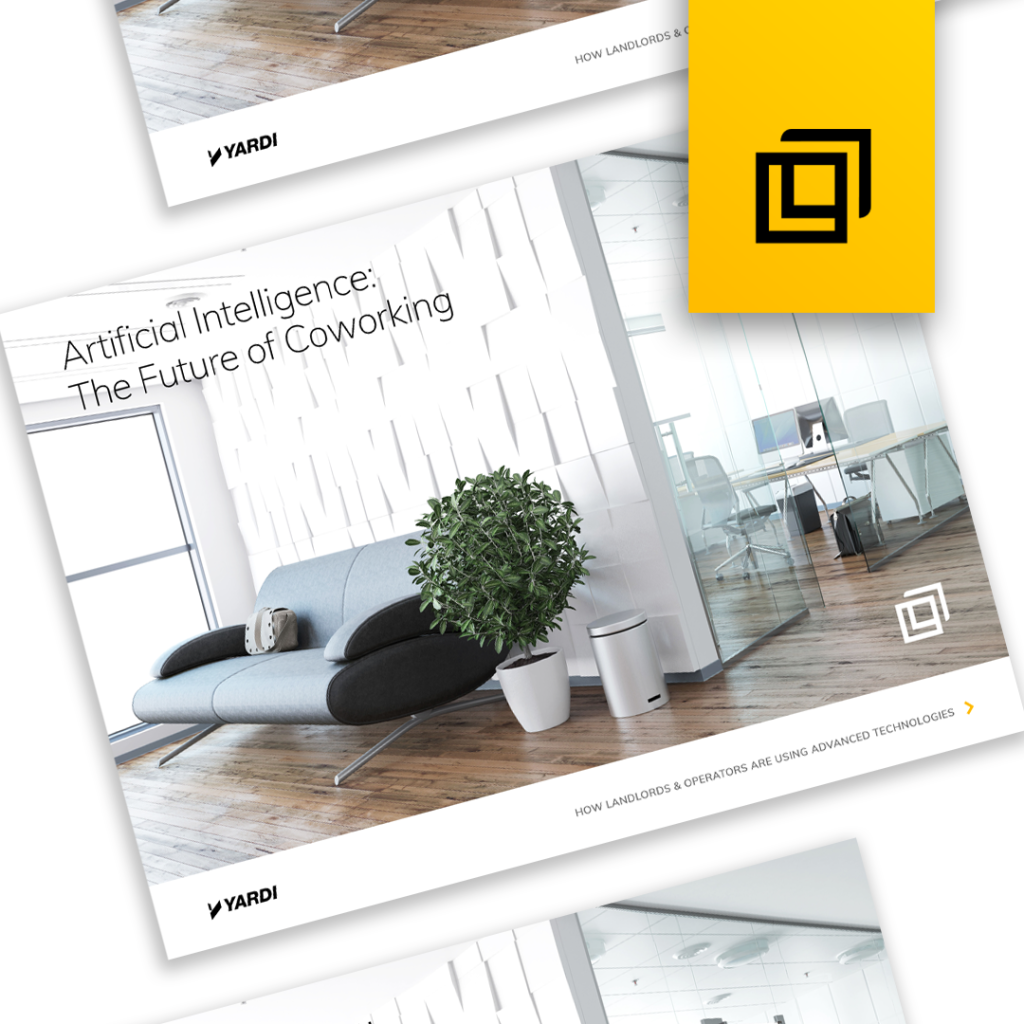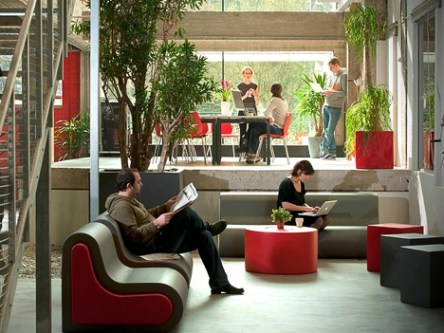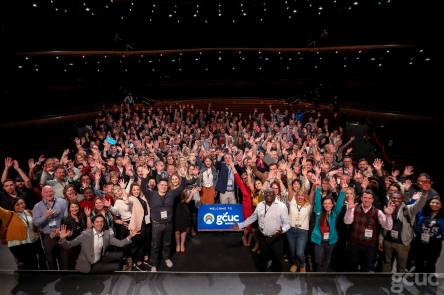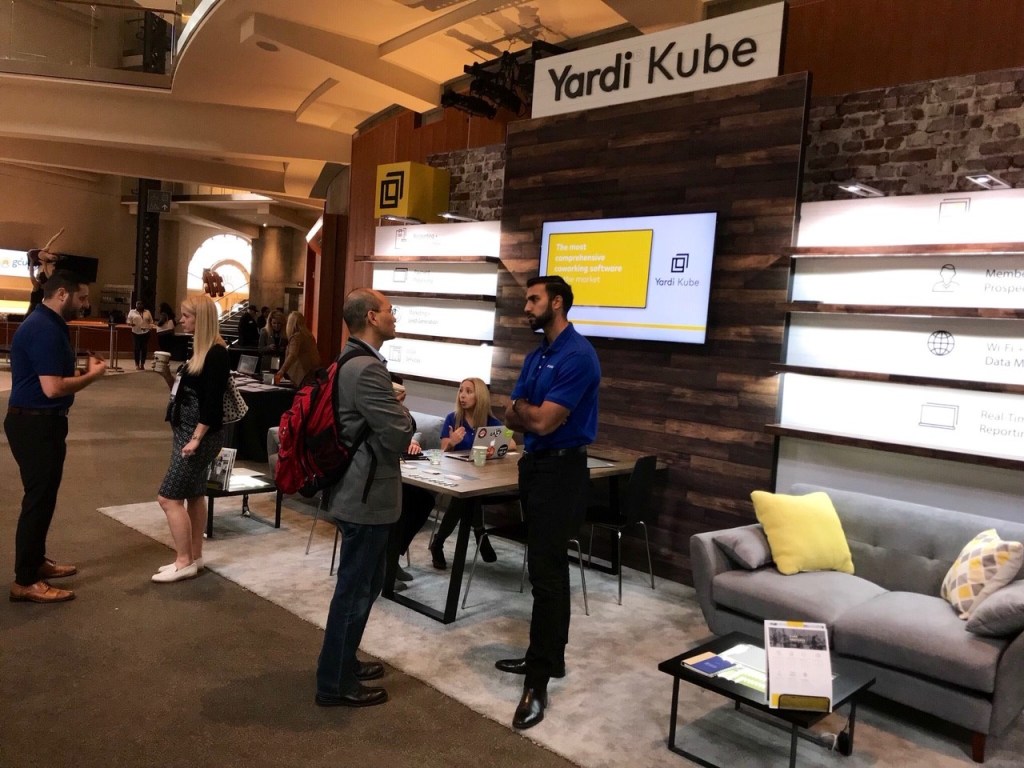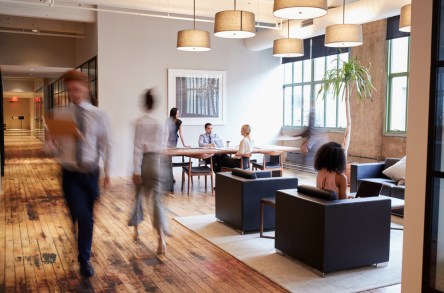Coworking centers are becoming a popular solution for many employees in a new, more flexible world of hybrid, remote, and in-office work. Let’s explore the benefits of a coworking center. Desirability: Coworking centers are attractive to workers. They typically incorporate open space, bright light, modern layouts and an artistic environment. Some even have private rooftop terraces that overlook city skylines. Find several cities worldwide that now have coworking centers. Flexibility: As office workers adapt to new normal, flexibility is the most productive and efficient way to respond to change. Flexible office space is an ideal workplace compromise. Use of a coworking center forgoes the need to hot desk or hotel existing traditional office space – sharable space with needed amenities is already provided, as are collaborative meeting spaces. And since coworking centers are shared spaces, employers can pay monthly without committing to a long lease. Ease of use: Coworking centers will keep up with frequent technology changes. Coworking centers will always have high-speed internet and WiFi. In addition, coworking centers offer video and audio-enabled conference rooms, modern computer systems, improved HVAC systems, member mobile apps for easy bookings, and touchless technology. Some centers may have smart windows to block the outside street noise or can adjust for the lighting needed. Other amenities of coworking centers include parking, electric vehicle charging stations, bike storage, espresso bars, wellness rooms, fitness centers, and event spaces. Some coworking centers are even dog-friendly! Pool tables, dartboards, and ping pong tables are also available in coworking centers for enjoyable mental breaks. Collaboration: Coworking centers offer collaboration opportunities for employers and employees. Working in a virtual work environment, some forms of human contact are lost. When the team can unite in-person, collaborative work and creative ideas are cultivated. The saying “two heads are better than one” is still relevant, especially when working on projects, sales pitches and leads, and event planning. Coming together in a positive space gives the team a chance to brainstorm, collaborate, mentor, and build company culture. Community: Being in a coworking center builds a self-nurturing community among startups, freelancers, creative professionals, and corporate employees who need a focused workspace. The community of coworkers makes the workspace engaging and vibrant, elevating mood and performance. Plus, coworking centers are often located in busy metro areas. Many coworking centers will be found by gyms and restaurants, allowing employees to enjoy city life in conjunction with the coworking experience. Modern offices, equipped with high-end technology, customer-oriented amenities and features, and open space design, will be a requirement if companies decide to pursue a full-scale return to the office. Flexible coworking centers are the ideal compromise: they allow employees to work when and where they feel most comfortable, while preserving the critical benefits of in-person collaboration and...
Creative Coworking
Thinking outside the office
As companies embrace hybrid work, flexible workspaces are becoming a popular solution for many employees. But how can owners and managers of coworking space – which is in major growth mode – raise the bar and make coworking spaces not just attractive, but irresistible? Here are some creative ways to attract workers to coworking spaces. The main advantage of coworking in flexible spaces is typically the open-plan space designs. Gone are the cubicles and assigned desks. Now you can have more room to enable collaboration with team members and other users in the office. But let’s take it up a step further and include a robust coffee and snack bar Include all the fancy fixings for coffee and cold brew, like syrups and creamers. You can include a snack bar with healthy options of various protein bars, fruits, and plant-based snacks. If your budget cannot bring the amenities into the office space, pick a location close to a trendy coffee shop. Think outside the typical Starbucks coffee location and look for a popular local coffee café. Coffee shops that offer a variety of drip coffee, CBD coffee, artisan coffee, and even various teas will be more attractive than just a typical Starbucks or Dunkin Donuts. Another creative way to attract employees to flexible coworking spaces may be to have the office next to a doggie daycare facility. Since the pandemic started, many people have become very close to their fur babies. Leaving Snoopy at home all day alone is traumatizing for both owner and dog. Some doggie daycare facilities may even offer a discount for businesses nearby. Workers can come and have a focused workday, and Snoopy can have a day of play and exercise. You could even take it a step further...
Shared Perspectives
The Buildings Show Panel
Simply providing an open desk isn’t enough for coworking and flexible workspace providers in Canada. What else must space operators do to attract and retain tenants in this dynamic business? That was the topic of a recent panel discussion moderated by Warren Hersowitz, regional sales manager for Yardi Kube. The session at The Buildings Show in Toronto explored ways that space providers can serve members and improve staff efficiency at all stages of the business, from lead generation, IT infrastructure, and space and member management to accounting. Here is a recap of the key points discussed among panelists Christine Andrews, founder of Toronto coworking space provider Acme Works and a founder of Deco Group, a consultancy, and Kane Willmott, cofounder and CEO of iQ Offices, Canada’s largest independent coworking company. Maximize the member experience Creating value in a coworking space requires more than “just good coffee and Wi-Fi,” said Andrews. Settings that are attractive, enable flexible use of furniture and other items and provide opportunities for human connections help operators differentiate their offerings from competitors. “You, and your tenant, will get more out of the spaces when you include the human experience. Only focusing on the space misses an opportunity to charge more per square foot,” added Willmott. He described workspace leasing as shifting from a business-to-business model to business to consumer. Augment the experience with tech With shared space more prominent in the post-pandemic world, technology for managing shared space can make the difference. “Prospective tenants are less inclined to tour the space. That’s where a website that operators can use to post amenities as well as manage leasing and operations management makes a big difference,” Andrews said, adding, “Look for solutions that make it easier for your staff by speeding up the...
Meet CoworkingCafe.com
End-to-end coworking solution
The Yardi suite of coworking and flex space tools expands today with the launch of CoworkingCafe.com and the acquisition of CoworkingMag.com. Operators of coworking and flex space can take advantage of Yardi’s market leading lead generation, as well as a new feature to allow real-time bookings for conference rooms and private offices. When combined with Yardi Kube for coworking operations and accounting, Yardi has the very first end-to-end coworking solution for flex operators and owners. CoworkingCafe: For Operators & Occupiers CoworkingCafe.com publishes coworking and flex locations across the country, including real-time availability, amenities and packages, photographs, floor plans and even 360-degree videos. The sleek design offers a seamless experience for researching and booking workspaces, all in one app. From an extensive selection of top coworking brands, users can book and pay for a desk, office, meeting room or a complete office package in just a few clicks. CoworkingCafe.com joins the five existing Yardi commercial listing platforms, CommercialCafe, CommercialSearch, PropertyShark, 42Floors, and Point2, all of which now show coworking availability alongside traditional commercial listings. Together, these sites attract 2 million monthly visits and generate 300,000 high quality leads per year. Coworking operators can now manage inventory, marketing collateral, availability and pricing from a centralized dashboard, while workspaces are marketed across the entire listings network. Yardi Kube clients have the added advantage of managing marketing collateral and availability natively, along with operations, accounting, customer contracts, communications, data and Wi-Fi – a single, connected, end-to-end solution. “With the launch of CoworkingCafe, we are excited to help consumers find and book office space, while helping operators increase revenue,” said Rob Teel, senior vice president at Yardi. CoworkingMag Joins the Team Yardi also announces its recent acquisition of CoworkingMag.com, the go-to source for coworking news and trends. CoworkingMag consistently ranks among the top results for coworking-related searches for locations in the U.S. This addition enhances the power of the Yardi listings network and boosts both visibility and leads for all coworking clients. “The acquisition of CoworkingMag accelerates our efforts with its strong online presence and our Kube clients benefit from an expanded audience for their availabilities,” Teel added. “Together, these products provide unmatched value both to consumers and operators.” The Complete Coworking Platform: Yardi Kube Yardi Kube is the most powerful coworking management software on the market, bringing automation, flexibility, and ease to workspace management. The all-in-one platform handles everything from listing and booking coworking spaces — complete with mobile app — to day-to-day operations management and even automates the sales process from lead generation to proposal and execution. For more information about how CoworkingCafe and Yardi Kube streamline operations and increase revenue, contact us/book a demo...
Future of Coworking
AI & Internet of Things
One of the most significant trends in coworking and throughout the commercial real estate industry, is the advancement of uses for Artificial Intelligence (AI) and the Internet of Things (IoT). For managers and landlords, it leads to improvements in operational simplicity, features that increase revenue and reduce long-term costs with short-term investment. In our newest eBook, we analyze how AI and the IoT impact shared workspaces today and moving forward. We look at the most prevalent applications of advanced technologies in coworking then examine data on AI implementation and how it has evolved quickly over the past few years. Victor Vasev, Yardi senior director of coworking, explains how the Yardi Kube platform is using AI and IoT to help operators facilitate day-to-day business and adhere to social distancing guidelines for members. Finally, what is next for AI? Our eBook concludes with a look at the next steps for AI in the commercial and coworking sectors. Introduction to AI For the last decade, there has been consistent and rapid growth of coworking which has run parallel to the increase in the uses and potential for AI and IoT. Just about every aspect of our lives – comfort at home, entertainment, energy efficiency, transportation and now social distancing – have been altered by smart technology. The definitions of AI and IoT are intertwined, yet unique. The Internet of Things are internet-enabled devices, connected to collect and share data. Artificial Intelligence means your software gathers data, processes information and analyzes or makes predictions based off that data. In short, IoT is about connection and performing tasks, like requesting that Alexa turn down the temperature on your Nest thermostat. Artificial Intelligence goes beyond what human analysis is capable of to draw conclusions from data, like the Nest itself...
Home, Office
Multifamily + Coworking
Home is where the heart is, as well as the home office for some. All the time at home in front of a computer, however, can lead to feelings of isolation, a lack of inspiration, and a lack of meeting space for collaboration. Remote employees and freelancers turn to coworking spaces for help. To avoid a hectic commute, they seek coworking offices that are as close to home as possible. Herein lies renters’ problem that is an opportunity for multifamily and coworking owners. As the number of digital nomads grows, it outpaces coworking space availability especially in midsize and tertiary markets. Many multifamily communities aren’t equipped with the space, staff, or equipment needed to successfully operate their own coworking space on premises. This is where a collaboration between coworking organizations and multifamily properties can fill the void. Renters want coworking space but providers face challenges The 2020 National Multi-housing Council & Kingsley Apartment Resident Preferences Survey indicates that 46% of renters are interested in coworking space as a community amenity. Additionally, 48% are interested in conference or meeting rooms and 37% take interest in makerspace and DIY rooms. Unfortunately for renters outside of major metropolitan areas, coworking spaces are too far away, face limited availability, or are quite pricey. Some property managers will accommodate renters by creating a coworking space within the community. When space and staff are limited, that simply isn’t an option. For coworking firms outside of major metros, high rents may necessary to stay afloat with inconsistent membership revenues. A reliable base of clients would offer stability and an opportunity for growth but getting such leads is a struggle. Multifamily property and coworking leadership may be able to work together with mutual benefit. Considerations for coworking and multifamily property managers Space...
Shared Space Moving Up
Matrix Special Report
The coworking industry is growing rapidly, encompassing 93.2 million square feet in the top 50 U.S. office markets and making inroads in suburban spaces as well. A new special report from Yardi Matrix portrays a practice that thrives in cities with large technology sectors and in markets with office vacancy rates significantly below the 13.5% national average, including Manhattan, N.Y., San Francisco, Seattle and Boston. Areas with vacancy rates in the high teens, among them Houston and Dallas, have much less coworking space as a percentage of total stock. While 47% of coworking space is concentrated in just six traditional primary commercial real estate markets—New York City, Los Angeles, Washington, D.C., Chicago, Boston and San Francisco—“we expect that coworking will rise in suburban office markets” as the industry matures, the report says. These areas tend to draw clients from home-based workers who want an office for work and socializing purposes and from large corporations that establish small satellite offices. While highly visible turmoil surrounding industry leader WeWork fosters the impression that the entire business model is at risk, “most signs point to coworking as a growth industry that remains in the early stages of development,” the report says. New business models, such as establishing coworking properties in shopping malls and other non-traditional settings, are emerging as well. Get up to speed on all of this dynamic segment’s moving parts, prospects for further growth and risk factors in the new Yardi Matrix special report, “Shared Space: Coworking’s Rapid Growth Set to be...
Coworking Tech Success...
How Us&Co Does It
With shared space workplaces becoming ever more common, it’s important to have the right technology to ensure client success and happiness. Us&Co offers private offices and coworking space in London and Dublin and has a devised a successful model that serves professionals of all kinds. We spoke with Sylvi Wilamowska, head of operations at Us&Co, to find out how on-site tech fits into that experience. An experienced Industry professional, Wilamowska enjoys helping businesses grow and succeed by providing professional workspace they can be proud of, and by taking away the hassle of day to day building management of their own space. Tell us about Us&Co and the company values, mission & objectives? Wilamowska: Us&Co seeks to provide beautifully designed, high-end, professional workspaces, with a variety of uses. We offer our clients space where they can grow and thrive, which is complimented by first class service, delivered by our onsite team and partners. We are strong on design and appeal to a wide variety of businesses. We major on quality furniture, good natural light and space. Whether our clients are from the financial or tech sectors, they expect excellent IT both in the offices and throughout our extensive break out areas. Client satisfaction and therefore retention is our main objective which we achieve through attentive service from our staff and the best systems available. How does Us&Co fit into that? Wilamowska: The market is expanding fast but so is demand. Some markets are becoming overly competitive and some operators are doing unsustainable deals which are creating challenging trading conditions. At Us&Co, we both own and operate our buildings which gives us stability. We want to expand in a measured and controlled way with a long-term horizon. Prior to the relationship with Medusa, what were the...
Shared Workspaces
10 Tips for Multifamily
Looking for a way to increase occupancy without slashing prices? Creative value-add amenities can distinguish your property from competitors. One such value-add feature is a coworking space. The demand for shared work spaces is on the rise. You can benefit from this by transforming an existing area into a coworking space for residents. Coworking Spaces for Multifamily? Nationwide, there are more than 57.3 million freelancers. In corporate America, 55 percent of hiring managers believe telecommuting among full-time employees is becoming a staple in their business structure. That number is expected to rise. Employers responded that nearly 38 percent of their workforce will be telecommuting within the next decade. So where are all of these freelancers and remote employees getting their work done? Their homes and coffee shops, mostly. Fortunately for you, you can be both and attract the revenue for yourself. You can create a shared workspace on your property by converting an existing conference room or business office. Add some chairs and a coffee maker and you’re done! Almost .. here’s the next steps. Must-Have Coworking Space Features Coworking offices are profitable and you can benefit from their popularity and capacity to drive revenue. You will, however, need more than a coffee maker and some chairs to get the most out of the space’s earning potential. Here are five must-haves to make your space functional. High-speed connectivity is a must. You will need to decide whether wi-fi or cable connection is right for your building. Comfortable, customizable seating is just as important as connectivity. Workers must feel comfortable if you want them to return and perceive your workspace as a reason to sign or renew their lease. To increase comfort, equip your space with a combination of adjustable office chairs at desks and...
Coworking Marketing
Strategies and Ideas
As the coworking and shared space industry continues to grow and evolve, it’s becoming much more evident that profitability is not only viable, there are ways to maximize and continue to grow your profits as an operator. Let’s dive into the best coworking marketing strategy for maximum growth. Host Events You’ve likely heard about the potential for fantastic events at coworking spaces. One of the major keys to building your brand is to hold events that are open to the local community. It’s free advertising! People who would otherwise have never stepped foot in your space get firsthand access to all the benefits your space provides. Even if they are not coworking candidates, word of mouth is one of your biggest assets. The more people know about your location, have been inside and can speak to its benefits, the better for you of course. Here are some ideas for events that you could organize within your space: Community panel discussions ‘Breakfast and Learn’ / happy hours Singles’ meetup events Yoga classes Also, keep in mind, if your space does not have 24/7 access, a great way to increase revenue is to host private events after hours. Whether it’s birthday parties, receptions, sporting event watch parties, or just about anything else that you have the room for and would take place past typical working hours. Last year’s Global Coworking Survey revealed that 21% of operators found organizing events to be a top challenge for them, and 50% said attracting new members was a top challenge. These events, whether during or after hours, will solve for a large part of both of those obstacles. Want to learn more about coworking marketing strategies? Check out the rest of this post on the Yardi Kube...
Coworking Outlook
Changing the tech landscape
Editor’s note: this coworking perspective piece was authored by Justin Harley, regional director of coworking for Yardi, in association with Property Week. Harley was a co-founder of the flexible workspace management software Hubcreate. He joined the Yardi UK team in May. Having spent most of my career in the flexible workspace sector, I could not be more enthusiastic about how bright the future is for coworking and flexspace, and furthermore I am delighted to see technology and software leaders such as Yardi investing heavily in technology to fuel the growth and development of the sector. I have been privileged to see the coworking and flexspace sector grow from a few London-based serviced offices to what it is today, one of the fastest-growing parts of the real estate world. That said, it still only accounts for 4% of all deals in London, according to the latest research from Cushman & Wakefield and Colliers International. While real estate continues to develop an understanding of the coworking market, the industry is still a little shell-shocked about how it has crept up on them. That part of the real estate sector often misses the point when they debate coworking. I hear “we are not coworking, coworking doesn’t make money – when will the bubble burst?” Larger operators account for less than 13% of the market in the UK and the flexspace and coworking community is made up of businesses that care about innovation, member experience and the effect of their service on worker wellness. In short, it’s all about the customers and what makes them happy. Their obsession for customer service is what drives the industry. A happy client is a loyal client and, despite being on a flexible license, will stay for a long time. It is...
GCUC Recap
Coworking Conference Insights
Last month, Yardi Kube was introduced to the coworking world at the Global Coworking Unconference Conference (GCUC). The U.S. edition of the annual event was held in Denver from April 15-18. This popular coworking industry gathering provides attendees with extensive in-depth sessions with experts in the coworking space, educating them on financing, technology, community building, and branding. The first day of the event was a deep dive into especially hot topics for the coworking industry. Industry hot topics: making money Led by Jerome Chang of Blankspaces, the finance discussion focused on the number one way to make money as a coworking operator – through lease incentives. Fundraising methods for shared space startups include venture capital funding, personal loans, investment from friends and family members, and other avenues, but Chang shared that SBA loans for such businesses are unlikely. The average traditional office space will have about 165-185 square feet per employee. In a coworking space it could be as low as 50-70 square feet. Coworking operators can book common areas at up to 150 percent capacity, because your space won’t always be full (this uses the same logic as a gym membership: it’s possible to overbook because not everyone works out simultaneously). The biggest moneymaker, however, will be meeting rooms. They’re priced higher per hour than any other amenity or space in and should be rentable to the general public, as well as members. Virtual memberships provide a low-cost entry to members wanting to try out the industry. While individually, these memberships won’t be a primary source of income, it is a source of unlimited potential with no space restrictions. The Blankspaces model allocates 35-50 percent of space to private offices, Chang shared. And it’s important to make over 70 percent of your total available square footage...
Shifting Spaces
Office Market Update
While industry fundamentals are healthy and the economy is strong, the U.S. office sector faces pressures that could fundamentally alter its business model. Jeff Adler and Jack Kern, vice president and director of institutional research, respectively, for Yardi Matrix, provided an update on a sector in transition in a recent webinar. After a shaky fourth quarter of 2018, the U.S. economy has rebounded into “really good shape,” Adler said, with a rising stock market and inflation that is largely held in check by increased domestic oil production. The labor market is very tight—the best in 50 years, he said—with office-using sectors outpacing overall job and wage growth over the past five years and most markets absorbing available office space. Metros such as Dallas, Houston and Atlanta are growing fast and adding office-using jobs. Other locations with job growth and low unemployment, such as Orlando, Fla., Nashville, Tenn., San Francisco and the nearby Bay Area, have to import workers to meet staffing needs. Most markets still have room to absorb office space. In short, the industry is in a good place, and if the federal government’s pro-growth policies outweigh its anti-growth ones, “the party goes on,” Adler said. So what are the challenges? One of the main secular (long-term) factors is coworking, which pulls 1-3% of market demand from traditional office leases and keeps growing as companies expand beyond their primary locations. The practice is growing everywhere and won’t likely go away anytime soon, Adler said. Per-employee square footage is decreasing, particularly in central business districts and high-cost metros. With a tight labor market, companies are luring talent by making office “an experience-driven sector,” similar to what has happened in retail, incorporating design elements and attractions such as new technology, spaces for relaxation, natural light,...
Flexible Workspace
Topic of Yardi Think Tank
Yardi assembled a panel of flexible office experts to discuss the importance of a service ethos, how workspace providers can stand out from the competition and why the sector looks well placed to weather a possible recession. Panelists Gareth Evans, chief executive of BizSpace Katrina Larkin, co-founder of Fora Cal Lee, founder of WorkThere William Newton, president of Wiredscore Katie Whell, managing director at Pure Offices Tony Freeth, director of coworking at Yardi Simon Creasey, features editor at Property Week (chair) Flexible workspaces have been hailed as the future of offices, but as the business model continues to mature many questions arise about what this future might look like. To debate what lies ahead for flexible workspaces, Yardi put together a panel of some of the industry’s heavyweights. SC: How important is customer service for the coworking industry? GE: Customer service is what it’s all about. It’s quite interesting as a concept because one person’s customer service is another person’s lack of service. It depends on where you are regionally, what kind of centre you’re in and what people’s needs are. You can provide frothy coffee or whatever, but if that’s not what the customer wants then you’re not providing good customer service. KL: Myself and [Fora co-founder] Enrico [Sanna] come from a hospitality background, not from a workplace background. So, for us, customer service is absolutely key. We have worked with one of the top hospitality schools in Switzerland to attract the best people from the hospitality industry. WN: Before WiredScore moved into WeWork, we were with a provider who clearly hadn’t yet got what service meant. Their front of house people were security people trying to prevent people getting into the building who shouldn’t be there rather than welcoming in guests who...
Introducing Yardi Kube
Single Platform Coworking Solution
Yardi Kube™, a single platform solution for coworking and shared workspace operators, is now available. Introduced this week at the GCUC conference in Denver, Yardi Kube is designed to help coworking operators successfully grow their businesses, eliminate third party integrations, save time and offer competitive member services. With the powerful Yardi Voyager property management platform as its foundation, Yardi Kube combines accounts payable, general ledger, merchant services and more in one easy-to-use technology suite. Yardi Kube includes comprehensive accounting, online marketing integration and powerful reporting capabilities. Users will be able to easily report to owners and investors and market to new clients, all from within the platform. The member portal gives coworking members the ability to manage their profile, connect with other members, pay bills, purchase services and book space with one click. Yardi Kube can also handle management of Wi-Fi and VOIP systems. “We chose Yardi Kube because of its robust capabilities to manage our businesses. The fact that Yardi was behind the development gave us confidence in its reliability and development path,” said Willie Gutierrez, COO and CFO of Premier Workspaces, a nationwide shared workspace provider. “Yardi Kube is the long-awaited technology solution that will allow shared workspaces to scale and grow with ease,” said Dale Hersowitz, vice president of coworking at Yardi. “It maximizes efficiency, eliminates leakage and allows for real-time reporting, all in a single platform.” GCUC, which concludes tomorrow, is the world’s largest coworking event, with conferences held in five continents. About 300 attendees convened in Colorado for the event. At GCUC, the Yardi Kube team has been conducting demos of the new platform and sharing the product’s exciting features, including the accounting platform, internet listing service and prospect lifecycle tracking. “We look forward to showing the extent of Yardi’s commitment to coworking, what the future looks like for Yardi Kube, and how the platform separates itself from the competition,” said Dale Hersowitz, vice president of coworking at Yardi. GCUC attendees are invited to come by the Yardi Kube booth, #10-11, to see Yardi Kube in action. Visit yardikube.com to learn more about the benefits of an all-in-one coworking management solution for shared...
Key Features
For Coworking Software
As an operator of a coworking space, you’ll have many choices when selecting a management platform to power your shared workspace. Compare pros and cons and check what features each choice provide, but make sure these five features are included in your software. Robust Accounting Accounting is a vital component to the operation of your space. You may choose a software that integrates with third party applications such as Quickbooks, FreshBooks, or others. That is a significant step up from manual labor. In a perfect world however, your management platform would have all accounting solutions built in. This will eliminate third party apps for accounts payable, payment processing, merchant services, and reconciliation, among other functions. ILS There are numerous benefits to having an ILS (internet listing service) built into your coworking management software. List your space and eliminate marketing time and dollars. Potential members can check out your space at a glance, and improve the quality of your leads. In addition, you will greatly benefit from the ability to sell your services online in real time. Offer spaces, services, and just about anything else you can list. Keep track of sales and revenue live. Real-time Reporting Real-time reporting goes beyond just statistics. Being able to track data and results live will help you track sales, revenue, space usage, and many more driving factors of the success of your space. At the end of the day, the goal is to increase your revenue and provide better service to your members and guests. Real time reporting is at the core of all those goals, as you’ll have visibility to change membership plans, designs, and service based on tracking data over periods of time. Learn more about the benefits of CRM and automated booking in your coworking management software on the...
Member Personas
For the coworking space
One of the most critical aspects to properly marketing your coworking space is building member personas. You could be doing tons of hard work and spending time and dollars on marketing, but if you’re not aiming at the right target, it could be all for nothing. Let’s take a look at how and why to build member personas. What are member personas? Imagine creating your ideal member, in detail. Consider what characteristics, habits, demographics, and many other factors formulate the member you would most associate with your space. For example, you could say ‘Tom’ is an entrepreneur, based in Miami, age 34, losing creative spark due to isolation, and needs to work a flexible schedule due to other demands. Tom is your target customer. This guide is a good way to check off the questions you need answered, so that you’re not just marketing to “everyone.” But why can’t you just target a wide scope and range of potential members? You’re bound to hit on some of them, yes, but for the most part this isn’t a prudent strategy. You’re going to be wasting your efforts targeting lots of personas that simply don’t match with what your space is all about. If your scope is too wide, your space will be too formal for some, too informal for others. It may be too large or too small. It may be out of driving distance. It may be out of budget. An important note from coworking marketing expert Cat Johnson is that your potential member can get a desk and Wi-Fi in many places. Make sure you are targeting someone who needs more than that, be it intangible features like community and collaboration, or tangible benefits like conference rooms and after hours access. Learn how to create...
Must-Have 2019 Tech
For the coworking space
While the coworking industry continues to expand, its important to keep up with the best new technology. Let’s take a look at some of the most latest critical tech components for coworking spaces. CRM Every coworking space should absolutely have a CRM in place. It is truly one of the most integral components to a modern thriving workspace. Not only does it assist in lead tracking, but a CRM will improve your relationships with your current and prospective members. A CRM will streamline lead entry, customer life cycle tracking, vendor relationship management, and many other operational tasks. It drives efficiency and will enhance productivity, and directly leads to greater profitability. The technology-driven corporate world we live in today demands a CRM. According to a study by Gartner, CRM will be the single largest revenue area of spending in enterprise software by the year 2021. Not only is the CRM going to be a core tool for sales and marketing, but it will also benefit customer service. Since your members are reaching out via social media, phone, chat, email, and any other method they can find, it’s important to consolidate all their interactions in one place. The uses of a robust CRM are virtually limitless for all aspects of a successful coworking space. Automated Billing Whether you operate one space or multiple locations, automated billing is a vital component for success. Consider the time you’re spending balancing and reconciling your books. Consider the outsourced cost if you hire a bookkeeper. With the market becoming more competitive, shared space supply is increasing, and organized operators can run more efficiently. In many cases, operators streamlining their business with automated billing (among other tech solutions) can offer the same product at a more competitive cost. Standout softwares combine an accounting package with merchant services. Yardi KUBE...
Yardi KUBE Preview
New, Single Platform Explained
Ed. Note: WUN KUBE has joined the family of Yardi property management software. KUBE provides a suite of technology products for coworking and shared space management. This piece on the new platform originally appeared on the KUBE Blog. As we approach the much anticipated release of the new Yardi KUBE platform, we conducted a client-exclusive Q&A session to address a variety of topics. The response was overwhelmingly positive and we cannot wait to debut the new KUBE. We will beta launch in January 2019, and full roll-out is set for April. Below, we’re going to summarize some of the main talking points from the recent webinar. What are the main changes for KUBE? It’s tough to put into words exactly the incredible extent to which Yardi is impacting our platform, but we tried to do so again in the webinar. Dale Hersowitz, our VP of Coworking, explained that Yardi is best known for building software for the real estate industry, from commercial to multiunit to many other facets. They are now fully diving into the Coworking world with the acquisition of WUN last year. The most important change for KUBE is essentially putting together a single stack. What does that mean? Yardi has a full general ledger suite, an accounting package, they’re also a merchant, they offer a vendor procurement solution, they are an e-broker, and KUBE will continue to provide the operational component to power your day to day functions of your space. No more third-party integrations. Yardi will encompass 7 modules in one tightly integrated solution. Everything in a single platform allows for greater efficiency, cost savings, prevents leakage, and enables operators to scale effectively. Enhancements and New Features The attendees asked several questions regarding the enhancements of the new platform. Yardi has a...
Relocation Incentives...
For telecommuters, renters, and homebuyers
Locales across the United States are using relocation packages to siphon talent from larger cities. The deals include everything from free rent to cash allowances and home appliances. The trend can mean notable government contracts for co-working spaces, multifamily and single-family housing providers. Each program is different, but many share common threads. Their marketing messages often aim to attract newcomers from cities where significant portions of income are directed towards housing. Several locales appeal to professionals in technology and science-based fields. One program has gained significant attention in recent weeks. Your New Home: Tulsa, Oklahoma The George Kaiser Family Foundation (GKFF) is currently accepting applications for its remote employee relocation program, Tulsa Remote. The Foundation is offering $10,000 cash, a rent-free furnished apartment, and a desk at 36 Degrees North, a local coworking space. In exchange, recipients must live in Tulsa full-time for at least one year. Recipients are also encouraged to participate in community events. Many of these social opportunities are created especially for program participants. Tulsa Remote recipients are invited to exclusive wine tastings, group outings, and neighborhood panel discussions. The hope, says GKFF’s executive director Ken Levitt, is that the transplants will establish a local community and decide to stay beyond the required year. In theory, the remote employees will not only bring cash into Tulsa. They will show local young professionals that they don’t have to leave their small-town home to be successful, suggests Sara Sutton, the CEO of FlexJobs, a remote job search engine. Tulsa Remote and similar programs remove the stigma from telecommuting, which some believe is not a “legitimate thing.” But telecommuting is quite a legitimate thing. A 2017 Gallup poll revealed that 43 percent of employed Americans have worked remotely in some capacity. The figure is...

